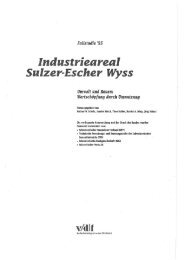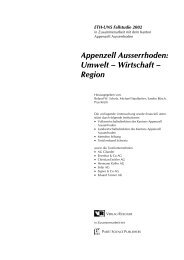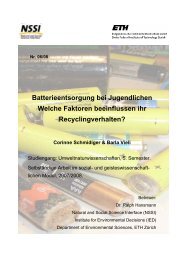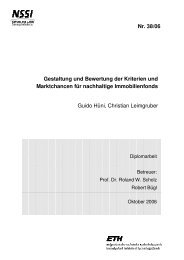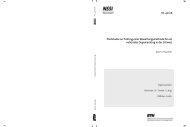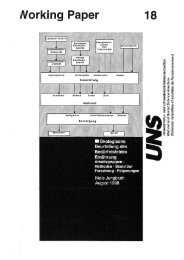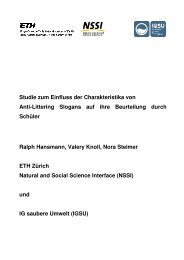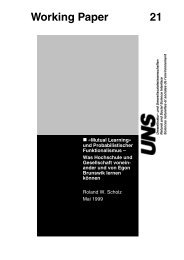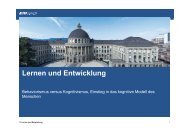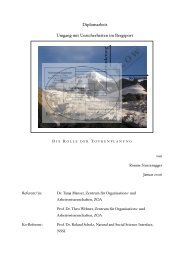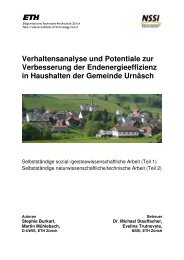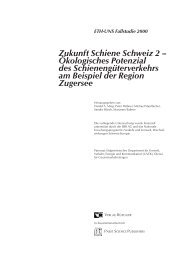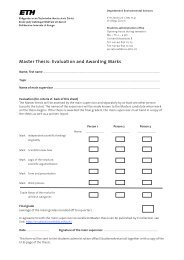Non-road fuel consumption and pollutant emissions ... - BAFU - CH
Non-road fuel consumption and pollutant emissions ... - BAFU - CH
Non-road fuel consumption and pollutant emissions ... - BAFU - CH
Create successful ePaper yourself
Turn your PDF publications into a flip-book with our unique Google optimized e-Paper software.
<strong>Non</strong>-<strong>road</strong> <strong>fuel</strong> <strong>consumption</strong> <strong>and</strong> <strong>pollutant</strong> <strong>emissions</strong> FOEN 2008 104<br />
9.2 Impacts of retrofitting with particle filters<br />
Figure 52 (left) shows the past <strong>and</strong> future development of PM <strong>emissions</strong> caused by<br />
construction machinery if no machines had been retrofitted with particle filter systems<br />
<strong>and</strong> no further retrofitting were to be carried out, in comparison with the retrofitting<br />
scenario. As we can see, particle <strong>emissions</strong> would be approximately twice as high in<br />
2010 as in the scenario with retrofitted machines.<br />
So far, no major retrofitting of agricultural machines has taken place. However, when<br />
EU stage IIIB enters into effect in 2012, new machines will have to be equipped with<br />
particle filter systems before they leave the factory. This means that, compared with the<br />
situation regarding construction machinery, the introduction of particle filters in the<br />
agricultural sector will commence at a relatively late stage.<br />
Construction machinery<br />
Agricultural machinery<br />
Figure 52 (right) shows how the situation with regard to agricultural machinery would<br />
change versus the scenario without retrofitted machines if new machines were to be<br />
equipped with particle filter systems already with effect from 2009. Compared with the<br />
situation in which new machines are only equipped with particle filter systems at a<br />
later date, in 2020 there would be a 17% reduction in PM <strong>emissions</strong> from agricultural<br />
machines. The impact of such a measure restricted to new machines is thus relatively<br />
minor, which can be attributed to the fact that agricultural machines are used over<br />
lengthy periods of time <strong>and</strong> the replacement rate (2600 tractors a year) is correspondingly<br />
low.<br />
In order to more effectively reduce <strong>emissions</strong>, it would be necessary to retrofit a larger<br />
number of older machines, since these have a higher specific level of PM <strong>emissions</strong><br />
that could be reduced with the aid of particle filter systems.<br />
Fig. 52 > Construction <strong>and</strong> agricultural machinery:<br />
particle <strong>emissions</strong> in 2005 <strong>and</strong> chronological development<br />
For construction machinery, “with retrofitting” corresponds to the reference scenario.<br />
For agricultural machinery “without retrofitting” reflects the reference scenario.<br />
The “with retrofitting” scenario corresponds to a premature introduction (in 2009) of a<br />
retrofitting obligation for new machines.<br />
Construction machinery<br />
Agricultural machinery<br />
t/a<br />
450<br />
400<br />
350<br />
300<br />
250<br />
200<br />
150<br />
100<br />
50<br />
0<br />
1990 1995 2000 2005 2010 2015 2020<br />
t/a<br />
450<br />
400<br />
350<br />
300<br />
250<br />
200<br />
150<br />
100<br />
50<br />
0<br />
2005 2010 2015 2020<br />
Scenario without retrofitting<br />
Scenario with retrofitting<br />
Retrofitting as described in section 5.5 (Fig. 20 on page 45).



